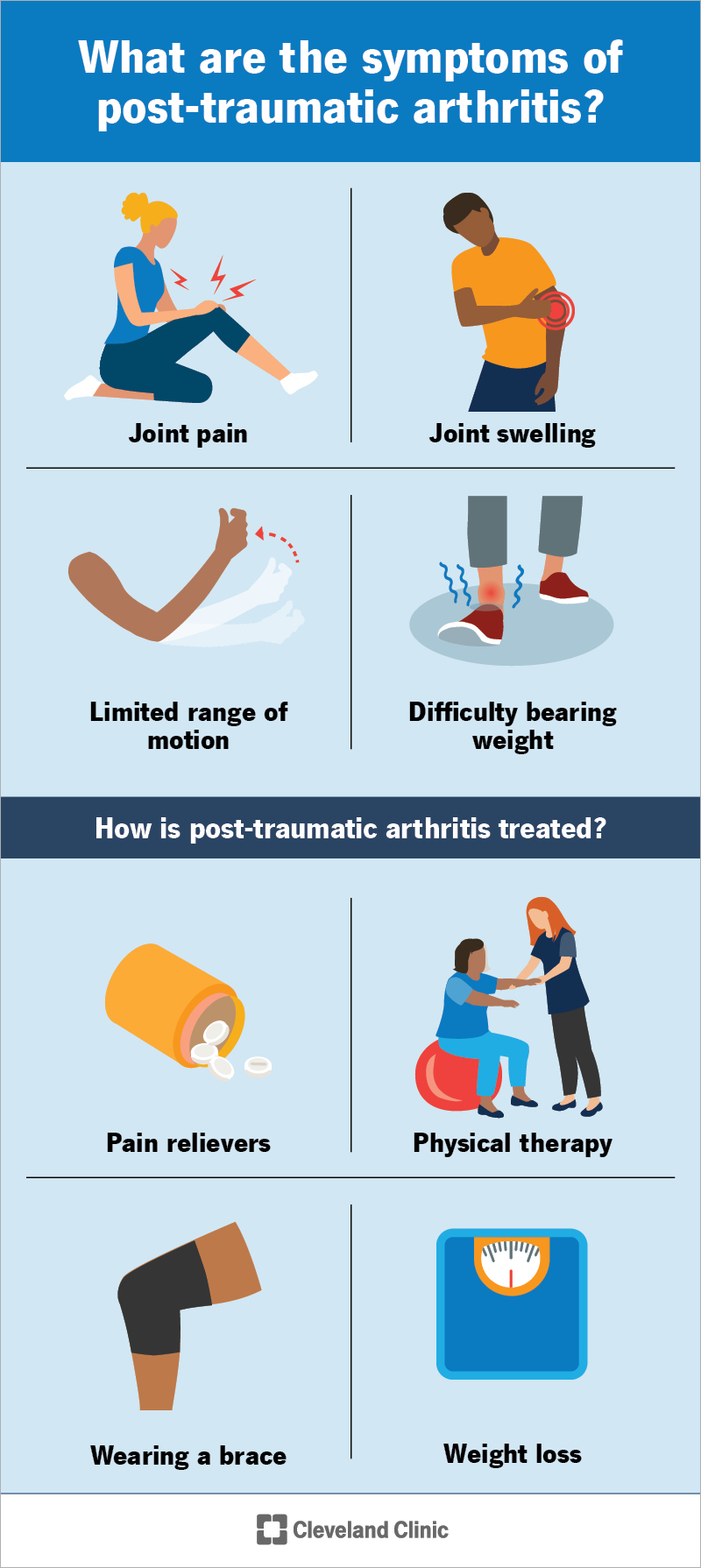Post-traumatic arthritis develops after a traumatic injury to your joint. It causes inflammation, swelling and pain. It’s usually temporary and easy to treat at home. Many treatments are the same as those you’d already be using to treat your injury.
Advertisement
Cleveland Clinic is a non-profit academic medical center. Advertising on our site helps support our mission. We do not endorse non-Cleveland Clinic products or services. Policy

Post-traumatic arthritis is inflammation in a joint that develops after a traumatic injury to it. It’s a degenerative type of arthritis, which means it’s from wear and tear on the joint. Usually, degenerative arthritis (osteoarthritis) takes a long time to develop. But when you have an injury, wear and tear on your joint adds up faster. Post-traumatic arthritis develops in weeks or months rather than years.
Advertisement
Cleveland Clinic is a non-profit academic medical center. Advertising on our site helps support our mission. We do not endorse non-Cleveland Clinic products or services. Policy
Fortunately, this sort of damage usually isn’t permanent, and post-traumatic arthritis is usually a temporary issue. Most people recover in a few months with home care. But some injuries can do more damage than others, and sometimes, post-traumatic arthritis becomes a long-term (chronic) condition. Though it’s rare, you might need surgery if your symptoms are severe and limit your quality of life.
Other terms for post-traumatic arthritis include:
Post-traumatic arthritis causes inflammation in your injured joint. Symptoms can include:
The joints most often affected by post-traumatic arthritis include your:
In severe cases, pieces of cartilage can break off and get stuck in your joint. This may cause:
Sometimes, severe post-traumatic arthritis doesn’t heal as expected. When it lasts more than six months, it’s considered a chronic condition. At this point, it becomes something else. Some scientists consider it to be the start of chronic osteoarthritis. This is a progressive condition, which means your joint continues to degenerate. Some also believe that it can trigger the start of inflammatory arthritis.
Advertisement
Traumatic injuries that impact your joints can cause post-traumatic arthritis. Common causes include:
Injuries that move or damage the bones in your joint can also damage the cartilage that surrounds them, leading to arthritis. Common types of injuries that can affect your bones and cartilage include:
Unlike most types of arthritis, post-traumatic arthritis is more common in younger people, including kids. It’s also more common in athletes and other active adults, who tend to get injured more often.
Your healthcare provider will diagnose post-traumatic arthritis with a physical exam and imaging tests. Your provider will move your joint, ask you about your symptoms and compare your joint and its range of motion (how far you can move that part of your body) to what it was before your injury — if possible. After your physical exam, you might need at least one of the following imaging tests of your joint:
Most people can treat post-traumatic arthritis at home. Treatment may include:
In rare circumstances, when your symptoms are severe and don’t seem to be improving, your healthcare provider might recommend surgery for post-traumatic arthritis. Surgical procedures might include:
Go to the emergency room if:
Most people have post-traumatic arthritis for only a few months. Your arthritis will typically improve as your body recovers from your trauma. But in rare, severe cases, you may continue to experience symptoms for longer than six months. This is called chronic post-traumatic arthritis. When it’s chronic, it may be lifelong. Your healthcare provider will help you to manage your condition in the long term.
Advertisement
Follow these general safety tips to reduce your risk of an injury:
When you’ve already had a traumatic injury, post-traumatic arthritis is an extra insult. It can be frustrating to develop a new complication while you’re recovering. But post-traumatic arthritis is usually temporary and easy to treat at home while you’re treating your injury. It doesn’t do permanent damage to your joints. In the rare event that it’s more severe and longer-lasting, surgery can treat it if necessary.
Advertisement
Stiff, painful joints can make daily life challenging. Cleveland Clinic orthopaedic specialists can help you find relief from osteoarthritis and get you moving again.

Last reviewed on 03/12/2025.
Learn more about the Health Library and our editorial process.